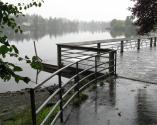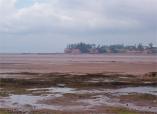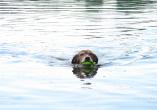I got a monster killer migraine yesterday afternoon, which went some way to explaining why fate didn’t want me travelling this weekend.
Before it hit, I did a bit of reading on the subject of plastic, which I wandered into through a story on the banning of plastic shopping bags. It made a nice change from the latest grim news for English farmers who are already struggling with the latest round of foot and mouth.
But it’s not a much more uplifting story, although the banning of plastic bags – something not unknown in Canada – is a good thing. Spending, as I have been lately, quite a bit of time Thameside in London, I’ve often noticed them floating in the water. The Thames is a tidal river, draining into the English Channel, so as my recent reading has been telling me, those plastic bags will ultimately end up as plastic fragments perhaps even flowing past my house on the Gorge in Victoria.
The interesting – if tiny – preview of a longer film called Synthetic Sea, produced by the Long Beach CA Algalita Marine Research Foundation, explains that plastic, as we should all know by now, is non biodegradable: which means that although it breaks down in time, it doesn’t disappear, it simply disassembles under sunlight – a process called photodegradation – into tiny plastic fragments which then wash around in the ocean, for centuries. Algalita believes that every piece of plastic ever created still exists.
In the the centre of the Pacific, Algalita took a random sample of sea water which showed there were six times as many plastic particles as there was plankton in the water. This means, of course, that plastic is competing with plankton as a food source for filter-feeding sea life (at the bottom of the food chain). The plastic becomes embedded in cell tissue of lower life forms like salps and is then ingested by larger sea life – on and on up to the fish on our dinner plate: I wonder if there is any way to find out how much plastic ends up in a salmon steak?
Not only does it threaten our food sources, plastic is also killing wildlife. Sea birds like albatross will eat larger plastic items like bottle caps and disposable lighters that fill and block their digestive system and kill them through starvation; others confuse tan coloured plastic fragments with krill or may eat nurdles – the pellets used by manufacturers to ship plastic for manufacture – thinking they are fish eggs. The problem here is that birds regurgitate their food for their young, many of whom die through malnutrition and the poisoning from the toxins that plastics carry. Whales and other sea animals are often found to have massive quantities of plastic – including balloons – in their digestive systems, and may also sustain injury or die when becoming trapped or tangled in discarded plastic.
So banning plastic bags is a good first step, but it’s not the end of the story. Plastic is lurking in all parts of our lives. I found a 2004 article in Science magazine that adds a caution about where else it’s hiding:
Many “biodegradable” plastics are composites with materials such as starch that biodegrade, leaving behind numerous, nondegradable, plastic fragments. Some cleaning agents also contain abrasive plastic fragments.
Like Algalita, the researchers found lots and lots of plastic fragments of all sizes; they found theirs in estuarine and subtidal sediments around Plymouth, and to check whether it was really something that all kinds of animal life would ingest, they kept “amphipods (detritivores), lugworms (deposit feeders), and barnacles (filter feeders) in aquaria with small quantities of microscopic plastics. All three species ingested plastics within a few days.” They couldn’t say what the long term effects of eating plastics might be on these or larger animals, but they do warn that “There is the potential for plastics to adsorb, release, and transport chemicals.”
A few statistics that are circulating on the web:
- The world uses over 1.2 trillion plastic bags a year. That averages about 300 bags for each adult on the planet. That comes out to over one million bags being used per minute.
- On average we use each plastic bag for approximately 12 minutes before disposing. It then lasts in the environment for decades.
- Not all litter is deliberate. 47% of wind borne litter escaping from landfills is plastic. Much of this is plastic bags. In the marine environment plastic bag litter is lethal, killing at least 100,000 birds, whales, seals and turtles every year. After an animal is killed by plastic bags, its body decomposes and the plastic is released back into the environment where it can kill again.
- In June 2006 United Nations Environmental Program report estimated that there are an average of 46,000 pieces of plastic debris floating on or near the surface of every square mile of ocean.










2 Responses to Plastic world